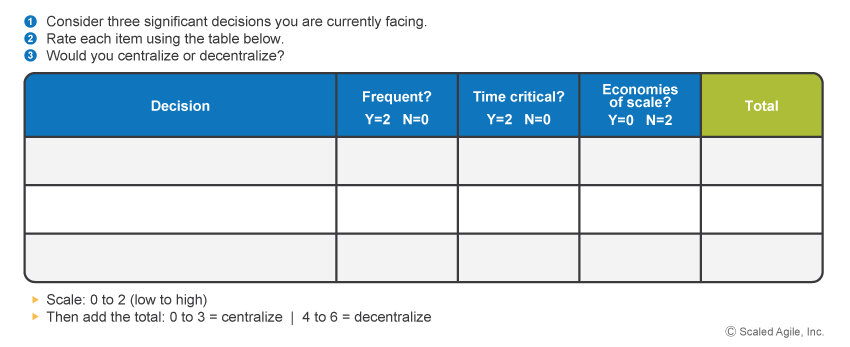Knowledge workers themselves are best placed to make decisions about how to perform their work.
—Peter F. Drucker
Principle #9 – Decentralize decision-making
Delivering value in the shortest sustainable lead time requires decentralized decision-making. It is a key tenet of Lean thinking. Any decision that must be escalated to higher levels of authority introduces a delay. Also, escalated decisions can decrease quality due to the lack of local context, plus changes to the facts on which they were based that occur during the waiting period.
Conversely, decentralizing decision-making reduces delays, improves product development flow and throughput, and facilitates faster feedback and more innovative solutions. Higher levels of empowerment are an additional, tangible benefit.
Centralize Strategic Decisions
Of course, not all decisions should be decentralized. Some decisions are strategic, have far-reaching impact, and are outside the scope, knowledge, or responsibilities of the teams. In addition, leaders are still accountable for outcomes. They also have the market knowledge, longer-range perspectives, and understanding of the business and financial landscape necessary to steer the enterprise.
Some decisions, then, should be centralized. Generally, they share the following characteristics:
- Infrequent – Made infrequently, these decisions typically are not urgent, and deeper consideration is appropriate (ex., product strategy, international expansion).
- Long-lasting – Once made, these decisions are unlikely to change at least in the short term (e.g., commitment to a standard technology platform, commitment to organizational realignment around Value Streams).
- Provide significant economies of scale – These choices deliver large and broad economic benefits (e.g., a common way of working, standard development languages, standard tooling, offshoring).
Leadership is charged with making these types of decisions, supported by the input of those stakeholders who are affected by the results.
Decentralize Everything Else
The vast majority of decisions do not reach the threshold of strategic importance. All other decisions should be decentralized. Characteristics of these types of decisions include:
- Frequent – The problems addressed by decentralized decisions are recurrent and common (e.g., Team and Program Backlog prioritization, real-time Agile Release Train [ART] scoping, response to defects and emerging issues).
- Time-critical – Delaying these types of decisions comes with a high cost of delay (e.g., point releases, customer emergencies, dependencies with other teams).
- Require local information – These decisions need specific local context, whether it be technology, organization, or specific customer or market impact (e.g., shipping a release to a specific customer, resolve a significant design problem, self-organization of individuals and teams to an emerging challenge).
Decentralized decisions should be made by the workers who have local context and detailed knowledge of the technical complexities of the current situation.
A Lightweight Thinking Tool for Decision-Making
Understanding how decisions are made helps enable knowledge workers to approach the decision-making process with a clearer point of view. Leadership’s responsibility is to establish the rules for decision-making (including, for example, the Economic Framework) and then empower others to make them. A simple tool or exercise for thinking about whether decisions should be centralized or decentralized is shown in Figure 1.

Leaders can practice with this tool and start to get a better understanding of what types of decisions they need to make, and what decisions are better left to those they lead.
Last update: 10 February 2021





